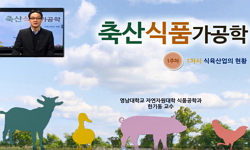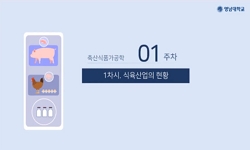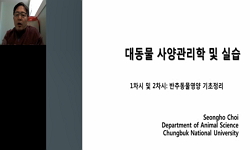Chicken not only serves as a high-protein source to humans, but it is also used as a suitable biomodel for increasing livestock productivity and studying human diseases. Chickens have numerous advantages as model organisms mainly because of they are r...
http://chineseinput.net/에서 pinyin(병음)방식으로 중국어를 변환할 수 있습니다.
변환된 중국어를 복사하여 사용하시면 됩니다.
- 中文 을 입력하시려면 zhongwen을 입력하시고 space를누르시면됩니다.
- 北京 을 입력하시려면 beijing을 입력하시고 space를 누르시면 됩니다.
https://www.riss.kr/link?id=A102592339
- 저자
- 발행기관
- 학술지명
- 권호사항
-
발행연도
2016
-
작성언어
Korean
- 주제어
-
등재정보
KCI등재
-
자료형태
학술저널
- 발행기관 URL
-
수록면
243-251(9쪽)
-
KCI 피인용횟수
1
- DOI식별코드
- 제공처
- 소장기관
-
0
상세조회 -
0
다운로드
부가정보
다국어 초록 (Multilingual Abstract)
Chicken not only serves as a high-protein source to humans, but it is also used as a suitable biomodel for increasing livestock productivity and studying human diseases. Chickens have numerous advantages as model organisms mainly because of they are relatively convenient to manage due to their small body size and short generational interval. In addition, they have a small genome size and numerous genes have biologically similar functions to those of human and livestock animals. In this review, we investigated the chicken biomodel for human disease research and the use of this model for increasing livestock productivity. This summary could provide useful and basic information for further development of strategies for enhancing livestock production and human disease studies.
참고문헌 (Reference)
1 Shi F, "Understanding mechanisms of vitiligo development in Smyth line of chickens by transcriptomic microarray analysis of evolving autoimmune lesions" 13 : 18-, 2012
2 Wang J, "Trimethylamine deposition in the egg yolk from laying hens with different FMO3 genotypes" 92 : 746-752, 2013
3 Giles JR, "The restricted ovulator chicken: A unique animal model for investigating the etiology of ovarian cancer" 20 : 738-744, 2010
4 Elkin RG, "The restricted ovulator chicken strain: An oviparous vertebrate model of reproductive dysfunction caused by a gene defect affecting an oocyte-specific receptor" 136 : 1-13, 2012
5 Stern CD, "The chick embryo–past, present and future as a model system in developmental biology" 12 : 1011-1013, 2004
6 Riddle RD, "Sonic hedgehog mediates the polarizing activity of the ZPA" 75 : 1401-1416, 1993
7 Akhtar S, "Sod1 deficiency reduces incubation time in mouse models of prion disease" 8 : e54454-, 2013
8 Spritz RA, "Six decades of vitiligo genetics: genome-wide studies provide insights into autoimmune pathogenesis" 132 : 268-273, 2012
9 International Chicken Genome Sequencing Consortium, "Sequence and comparative analysis of the chicken genome provide unique perspectives on vertebrate evolution" 432 : 695-716, 2004
10 Cipriani P, "Searching for a good model for systemic sclerosis: The molecular profile and vascular changes occurring in UCD-200 chickens strongly resemble the early phase of human systemic sclerosis" 12 : 828-843, 2016
1 Shi F, "Understanding mechanisms of vitiligo development in Smyth line of chickens by transcriptomic microarray analysis of evolving autoimmune lesions" 13 : 18-, 2012
2 Wang J, "Trimethylamine deposition in the egg yolk from laying hens with different FMO3 genotypes" 92 : 746-752, 2013
3 Giles JR, "The restricted ovulator chicken: A unique animal model for investigating the etiology of ovarian cancer" 20 : 738-744, 2010
4 Elkin RG, "The restricted ovulator chicken strain: An oviparous vertebrate model of reproductive dysfunction caused by a gene defect affecting an oocyte-specific receptor" 136 : 1-13, 2012
5 Stern CD, "The chick embryo–past, present and future as a model system in developmental biology" 12 : 1011-1013, 2004
6 Riddle RD, "Sonic hedgehog mediates the polarizing activity of the ZPA" 75 : 1401-1416, 1993
7 Akhtar S, "Sod1 deficiency reduces incubation time in mouse models of prion disease" 8 : e54454-, 2013
8 Spritz RA, "Six decades of vitiligo genetics: genome-wide studies provide insights into autoimmune pathogenesis" 132 : 268-273, 2012
9 International Chicken Genome Sequencing Consortium, "Sequence and comparative analysis of the chicken genome provide unique perspectives on vertebrate evolution" 432 : 695-716, 2004
10 Cipriani P, "Searching for a good model for systemic sclerosis: The molecular profile and vascular changes occurring in UCD-200 chickens strongly resemble the early phase of human systemic sclerosis" 12 : 828-843, 2016
11 Trojanowska M, "Role of PDGF in fibrotic diseases and systemic sclerosis" 47 : 2-4, 2008
12 Wilkinson JM, "Re-defining efficiency of feed use by livestock" 5 : 1014-1022, 2011
13 Semple-Rowland SL, "Rd and rc chickens carry the same GC1 null allele (GUCY1*)" 69 : 579-581, 1999
14 Sgonc R, "Pro- and anti-fibrotic effects of TGFbeta in scleroderma" 47 : 5-7, 2008
15 Muir WM, "Poultry Genetics, Breeding, and Biotechnology" CABI 2003
16 Babbs C, "Polydactyly in the mouse mutant Doublefoot involves altered Gli3 processing and is caused by a large deletion in cis to Indian hedgehog" 125 : 517-526, 2008
17 Zhang Z, "Parallel evolution of polydactyly traits in Chinese and European chickens" 11 : e0149010-, 2016
18 Jones DG, "Mutation restricting ovulation in chickens" 54 : 1780-1780, 1975
19 Lin S, "Let-7b regulates the expression of the growth hormone receptor gene in deletion-type dwarf chickens" 13 : 306-, 2012
20 Warren DC, "Inheritance of polydactylism in the fowl" 29 : 217-231, 1944
21 Ho KJ, "Hereditary hyperlipidemia in nonlaying chickens" 98 : 161-172, 1974
22 Dorshorst B, "Genomic regions associated with dermal hyperpigmentation, polydactyly and other morphological traits in the Silkie chicken" 101 : 339-350, 2010
23 Pinto D, "Genome-wide linkage scan of epilepsy-related photoparoxysmal electroencephalographic response: Evidence for linkage on chromosomes 7q32 and 16p13" 14 : 171-178, 2005
24 Jang HM, "Genome resequencing and bioinformatic analysis of SNP containing candidate genes in the autoimmune vitiligo Smyth line chicken model" 15 : 707-, 2014
25 Naquet R, "Genetic reflex epilepsy from chicken to man: Relations between genetic reflex epilepsy" 29 : 2002
26 Laron Z, "Genetic pituitary dwarfism with high serum concentation of growth hormone - a new inborn error of metabolism?" 2 : 152-155, 1966
27 Tauer U, "Genetic dissection of photosensitivity and its relation to idiopathic generalized epilepsy" 57 : 866-873, 2005
28 Yeung CK, "Functional characterization of genetic variants of human FMO3 associated with trimethylaminuria" 464 : 251-259, 2007
29 Tanaka M, "Expression of aberrantly spliced growth hormone receptor mRNA in the sex-linked dwarf chicken, Gifu 20" 5 : 218-223, 1995
30 Crawford RD, "Epileptiform seizures in domestic fowl" 61 : 185-188, 1970
31 Douaud M, "Epilepsy caused by an abnormal alternative splicing with dosage effect of the SV2A gene in a chicken model" 6 : e26932-, 2011
32 Knížetová H, "Effects of the sex linked dwarf gene (dw) on skeletal muscle cellularity in broiler chickens" 34 : 479-485, 2007
33 Agarwal SK, "Dysfunctional growth hormone receptor in a strain of sex-linked dwarf chicken: Evidence for a mutation in the intracellular domain" 142 : 427-434, 1994
34 Anthony NB, "Divergent selection for ascites: Development of susceptible and resistant lines" US Poultry & Egg Association 2003
35 Valdez DJ, "Differential regulation of feeding rhythms through a multiple-photoreceptor system in an avian model of blindness" 27 : 2702-2712, 2013
36 Vondell, JH, "Detection of chickens laying “Fishy Eggs”" 27 : 244-245, 1948
37 Nanda I, "Conserved synteny between the chicken Z sex chromosome and human chromosome 9 includes the male regulatory gene DMRT1: A comparative (re)view on avian sex determination" 89 : 67-78, 2000
38 Li H, "Chicken quantitative trait loci for growth and body composition associated with transforming growth factorbeta genes" 82 : 347-356, 2003
39 Bujo H, "Chicken oocyte growth is mediated by an eight ligand binding repeat member of the LDL receptor family" 13 : 5165-5175, 1994
40 Pollock CG, "Avian reproductive anatomy, physiology and endocrinology" 5 : 441-474, 2002
41 Wick G, "Avian models with spontaneous autoimmune diseases" 92 : 71-117, 2006
42 Song G, "Avian biomodels for use as pharmaceutical bioreactors and for studying human disease" 1229 : 69-75, 2011
43 Beyer C, "Animal models of systemic sclerosis: Prospects and limitations" 62 : 2831-2844, 2010
44 Schaeffel F, "Animal models in myopia research" 98 : 507-517, 2015
45 Wideman RF, "An inadequate pulmonary vascular capacity and susceptibility to pulmonary arterial hypertension in broilers" 86 : 984-998, 2007
46 Krishnamoorthy S, "A quantitative trait locus for ascites on chromosome 9 in broiler chicken lines" 93 : 307-317, 2014
47 Semple-Rowland SL, "A null mutation in the photoreceptor guanylate cyclase gene causes the retinal degeneration chicken phenotype" 95 : 1271-1276, 1998
48 Clark RM, "A novel candidate gene for mouse and human preaxial polydactyly with altered expression in limbs of Hemimelic extra-toes mutant mice" 67 : 19-27, 2000
49 Hierck BP, "A chicken model for DGCR6 as a modifier gene in the DiGeorge critical region" 56 : 440-448, 2004
동일학술지(권/호) 다른 논문
-
- 한국가금학회
- 김혜진(Hye-Jin Kim)
- 2016
- KCI등재
-
- 한국가금학회
- 이민희(Min Hee Lee)
- 2016
- KCI등재
-
한국 재래닭에서 지질대사 관련 유전자에 존재하는 유해성 nsSNP 발굴 및 생물학적 기능 예측
- 한국가금학회
- 오재돈(Jae-Don Oh)
- 2016
- KCI등재
-
GHSR 유전자 내 유전변이의 탐색과 한국재래계의 성장 및 산란 특성에 미치는 연관성 분석
- 한국가금학회
- 최소영(So-Young Choi)
- 2016
- KCI등재
분석정보
인용정보 인용지수 설명보기
학술지 이력
| 연월일 | 이력구분 | 이력상세 | 등재구분 |
|---|---|---|---|
| 2022 | 평가예정 | 재인증평가 신청대상 (재인증) | |
| 2019-01-01 | 평가 | 등재학술지 유지 (계속평가) |  |
| 2016-01-01 | 평가 | 등재학술지 유지 (계속평가) |  |
| 2012-01-01 | 평가 | 등재학술지 유지 (등재유지) |  |
| 2009-01-01 | 평가 | 등재학술지 선정 (등재후보2차) |  |
| 2007-01-01 | 평가 | 등재후보학술지 유지 (등재후보2차) |  |
| 2006-01-01 | 평가 | 등재후보 1차 PASS (등재후보1차) |  |
| 2004-01-01 | 평가 | 등재후보학술지 선정 (신규평가) |  |
학술지 인용정보
| 기준연도 | WOS-KCI 통합IF(2년) | KCIF(2년) | KCIF(3년) |
|---|---|---|---|
| 2016 | 0.35 | 0.35 | 0.34 |
| KCIF(4년) | KCIF(5년) | 중심성지수(3년) | 즉시성지수 |
| 0.39 | 0.36 | 0.643 | 0.13 |




 ScienceON
ScienceON DBpia
DBpia







